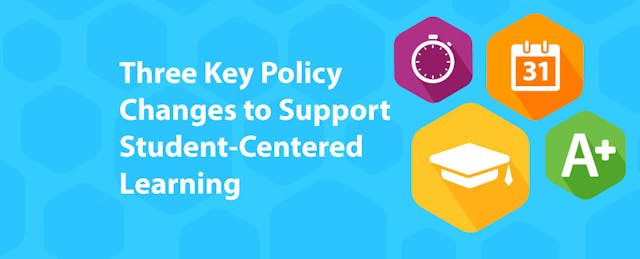Student-centered learning calls for students to learn at their own pace, and it requires school leaders to give students more choice over their instruction and to create more flexible learning environments.
These changes might force K-12 administrators to rethink long-standing policies. School leaders will need to ask themselves: Do the policies we currently have in place facilitate, or stand in the way of, this new approach to instruction?
Here are three key policy changes that can support the shift to a student-centered learning environment:
1. Pacing
To fully support student-centered learning, schools and districts must change their approach to pacing—moving students from one level to the next based not on a fixed school calendar, but on whether they have mastered the material.
School leaders could approach this challenge in different ways. Some might do away with grade levels altogether, while others might keep the traditional grade-level concept, but vary the content students receive based on their readiness, not how long they’ve studied a topic.
For instance, suppose a third-grade student was working at a fourth-grade level in math, but only a second-grade level in reading. In a traditional classroom, that student would be bored in math because he would be covering material he’s already mastered—but he would be struggling in reading because he would be given material beyond his ability.
In a student-centered learning environment, the student would be able to work at a fourth-grade level in math and when he was ready for more advanced work, he could progress to working on fifth-grade math—whether it was the middle of the school year or not. This same student would get instruction in reading at the second-grade level, perhaps with additional time to practice his skills and accelerate his learning up to standard grade level.
“We want to be able to meet students where they are and progress them from there,” said Rachael Turner, Transformation Manager for School Improvement Network.
2. Grading
Changing your approach to pacing will require a shift in grading policies as well.
For instance, if students are allowed to finish work at their own pace, how is this reflected in your grading system? If a student hasn’t met all the grade-level requirements in math by the end of the year, has he or she actually “failed” the course?
Many school districts have begun moving from a traditional letter-grade system to a standards-based grading system, especially at the elementary-school level. In these systems, the report cards show whether students have mastered, are progressing toward mastery, or have not begun to master each individual standard. This approach works well to support a student-centered learning environment.
“If you already have a standards-based grading system in the younger grades, have you considered extending that policy through the fifth, sixth, seventh, and eighth grades?” Turner asks.
In high school, things can get trickier as many colleges still expect schools to use letter grades or calculate a grade-point average for students. To account for this, school and district leaders might consider a “hybrid” approach that merges the concepts of standards-based and letter grades.
“Let’s say there are ten objectives in an algebra course,” Turner explains. “If a student masters 70 percent of those objectives by the end of the year, they get a C. If they’ve mastered 80 percent, they get a B.”
3. Scheduling
Giving students ownership of their learning is a key part of creating a student-centered learning environment. One way to do this is to give them the freedom to decide what they want to work on and when they want to work on it—as long as they meet course requirements.
At some progressive high schools across the country, students know they must earn a certain number of credits by the end of the first semester and a separate number of credits by the end of the year. They might choose to complete their algebra course all within the first few weeks of school by focusing solely on that course, then focus on English for the next few weeks; or they can take a more traditional approach by devoting an hour of every day to each of their courses.
“We like to compare that to the adult world,” Turner noted. “Some people wait to do all their cleaning on a Sunday, whereas others choose to do smaller amounts of laundry throughout the week. It’s what works best for that individual—and we want to apply that same standard to students: What works best for them, and how do they learn best?”
And while ultimately it’s this focus—what works best for each individual student—that ought to inform every decision in a school transitioning to a student-centered learning model, if leaders can first manage to effectively reshape pacing, grading, and scheduling in their schools, other pieces fall into place far more easily.



